When Brittany became Italian
Author
- Rémi Paolozzi
Date
- August 19, 2006
Related articles
- Bugatti Types 35, 37, 39 & 51 - The ideal privateer car, by Leif Snellman
- Guy Moll & Marcel Lehoux - Student & teacher, by Alessandro Silva
What?a postcard-souvenir from a prestigious race: the Coppa Florio Where?Saint-Brieuc, France When?July 17, 1927 |
 |
Why?
I come from a Breton village called Coëtmieux. It is about 15km east of the 50,000-inhabitant town of Saint-Brieuc, where Jean-Christophe Boullion, the 1995 Sauber F1 driver, was born in 1969. I used to go to this town by motorcycle, as the road passes through Hillion, Yffiniac and Langueux. As a youngster, I was already fond of motor racing. But, what I did not know at that time, is that the road from Yffiniac to Langueux was part of a former circuit which had been used many years ago. An important event happened there on July 17, 1927. On that day this little town had been the world capital of motorsport: the 10th Coppa Florio took place here.
I mean the Coppa, not the Targa
First of all it is essential to understand that the Coppa Florio has (nearly) nothing in common with the famous Targa Florio, except for the creator of both events: Vincenzo Florio. This Sicilian aristocrat, born in 1883, strongly believes in the future of the car industry. He knows that the best way to promote this new means of transportation is motor racing. So, in 1904 he organizes a race between Brescia, Cremona, Mantova and back to Brescia. The drivers have to run two laps of this 186km circuit. The race, called the Coppa Florio, is won by Vincenzo Lancia at the wheel of his Fiat. Vincenzo Florio himself takes part in the race, driving a Mercedes. He is third.
Then he decides to organize a challenge, called Coppa Florio again, based on speed and regularity. It is a seven-race challenge. The car manufacturer who wins the most of the seven races will be the winner of the Coppa Florio, the symbol of which is a sculpture designed by a Parisian artist, Polak. This statue is worth FRF 100,000. The first race takes place in 1905 on a 167km circuit between the same towns as above. There are three laps. The winner is Carlo Raggio (Itala) while Vincenzo Florio himself finishes 9th. The following year, the dynamic Florio organizes the very first Targa Florio, on his home island of Sicily. This first Targa is won by Alessandro Cagno with his Itala. This mythical race will eventually last until 1973.
Drivers and car manufacturers have to wait for 1907 to take part in the second Coppa Florio race. One more time it is around Brescia but the circuit is shorter (60km) and has to be run eight times. It is won by Ferdinando Minoia (Isotta-Fraschini). In 1908, the 10-lap race is taking place on a 52km circuit between Bologna, Castelfranco dell’Emilia and Persiceto, and is won by Felice Nazzaro with his Fiat. A 10-year-old boy is attending the race. It is the first time he is seeing cars race each other. His name is Enzo Ferrari.
Felice Nazzaro is the first driver to win two races of the challenge as he also wins in 1914. Nevertheless, this time he drives his own car: the Nazzaro. Moreover, for the first time the 1914 race is taking place in Sicily. Drivers have to run three times around the now famous Grande Circuito delle Madonie (148km).
The first post-war Coppa Florio race is set up in 1921 in Brescia, the cradle of the challenge. For the first time, a non-Italian car wins the race, a Ballot driven by Jules Goux. The following year, the race takes place in Sicily, on the Circuito delle Madonie (108km). The winner is Peugeot, another French manufacturer.
Then, two years later, the seventh - and theoretically last - race of the challenge is organized, but this time the Coppa Florio is integrated into the Targa Florio race. The winner of both the Cup and the Targa is Christian Werner at the wheel of his Mercedes. So, after nineteen years and seven races, no one has won the Coppa Florio since each race has been won by different cars.
So, an eighth race has to be organized, in 1925. Once again the Coppa is integrated into the Targa, as in 1923, in the Circuito delle Madonie. Meo Costantini (Bugatti) wins the Targa but the winner of the Coppa race is the same as in 1922, Peugeot, thanks to driver André Boillot. Do not forget that both the Targa and the Coppa have distinct regulations. The first one is a speed race whereas the second one is a mix of speed and regularity. Thus the French company from Sochaux wins the challenge, twenty years after its beginnings. The story could end like that. But, thanks to another man the Coppa Florio is going to live on for four more years. This man is called Lucien Rosengart.
Thanks to Rosengart's influence the French company decides to organize seven races in order to bring the cup into play. The first race occurs during the Targa Florio, on April 25, 1926, and the winner is Meo Costantini at the wheel of his Bugatti. The big change is for 1927 as Lucien Rosengart decides to set up the race in Saint-Brieuc. This is the first time a major race will be taking place in Brittany.
Mr Rosengart
Lucien Rosengart is born on June 11, 1881 in Paris. At the age of twelve he graduates in mechanical engineering while ten years later he establishes his manufacture of bolts and washers as well as a revolutionary screw which proves to be a big success. Thus, Lucien Rosengart becomes a rich inventor: he will register some 120 patents. Among them there are the baby-foot and the seat belt.
In 1906, while on vacation in Brittany, he falls in love with Les Rosaires, a small village on the Breton coast near Saint-Brieuc. There are only a few houses and a chapel. Along with an architect, he creates a sea-side resort and groups the opportunity to build a beautiful house with a view on the Channel. This house is now a sailing school.
Rosengart’s villa:
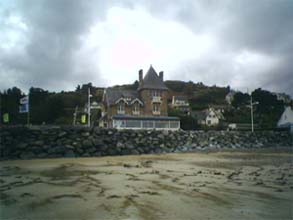
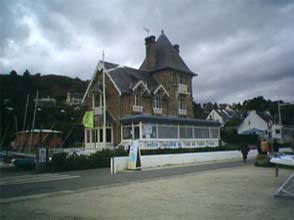
In 1914 he goes on to develop a rocket for the French army, building a plant in Paris and another one in Saint-Brieuc. He employs 4,500 workers out of which 900 come from the Breton town. André Citroën becomes his associate to manage the bomb business.
After World War I he helps Citroën and Peugeot avoid bankruptcy, and consequently, becomes an administrator of the latter company. He also sells a part of his Breton business but remains closely linked to Saint-Brieuc. This is the reason why after Peugeot’s victory in the 1925 Coppa Florio he decides to bring the Coppa into play and organize a race in the French town in 1927. During the same year he will also decide to become a true car manufacturer: one year later, in 1928, the first Rosengart LR2 is built. This car is actually a copy of the Austin Seven. The Rosengart car company will exist until 1955 but the boss will leave his business in 1939, to sell his company to the Société Industrielle de l’Ouest Parisien while preferring to live on the mediterranean coast, in Villefranche-sur-Mer, where he is able to dedicate his efforts to his passion of painting. Lucien Rosengart dies in 1976, at the age of 95, having been mayor of Villefranche for a few years.
The organization
Back to 1927 and the Automobile Club des Côtes-du-Nord, whose president Yves Périgois happens to be the organizer of the race with the help of French newspaper Ouest-Éclair, based in the Breton capital of Rennes. At this time the AC des Côtes-du-Nord (former name of Côtes-d’Armor) is totally independent from the Automobile Club de l’Ouest (ACO). The secretary general of Ouest-Éclair, Charles Frédouët, is also the Chief Commissioner of the Coppa Florio while the clerk of the race, of course, is none other than the famous Charles Faroux. Other commissioners are notables of Saint-Brieuc such as Mr Neumager, the owner of the biggest garage in town, or Mr Clerc, President of the Saint-Brieuc Bicycle Club.
Ouest-Éclair has financed the organisation of the race, costing them FF 1,000,000 (i.e. €500,000). The French newspaper also made a big promotion through its pages and is giving advice to the spectators who happen to be readers as well. Some of it is, well, from another century: "Follow calmly and happily the instructions given by the police." The one I prefer is this one: "Good news: there will be many tobacco shops all around the circuit." As Bob Dylan said, "Times, they are a-changing"… nowadays there is a big fight against tobacco consumption and promotion all over the European Union, also causing financial difficulties in motorsport. Through its pages, Ouest-Éclair tries also to recruit some marshalls, even days before the start of the race! Is it the sign of a good and well planned organization?
Part of the financing will come from the sale of tickets to spectators. A seat is worth FF40 to FF100 (€21 to €52) while the spectators will only be at the part of the circuit which is between Saint-Brieuc and Yffiniac. The grandstands will be situated about 300 meters before the Yffiniac bend, on the left-hand side of the track, whereas the pits will be on the right-hand side, just in front of the grandstands. If spectators prefers to stand up during the whole of the 4-hour race they only pay FF5 to FF20 (€2,5 to €10,5). Members of the AC des Côtes-du-Nord are the luckiest of them all: tickets are free for them.
So, if we make a quick calculation on 200,000 spectators, it will mean that the turnover of ticket sales could be around € 1,000,000.
A program is worth FF3 (1,5€) and is sold to finance the fight against tuberculosis. Each program is numbered. There will be a draw for the winning number after the race: the winner will be gifted a car.
As I said before, it is the very first time when such an important car race is organiszed in Brittany. It is a big event and the mayor of Saint-Brieuc has decided to decorate the town in gold and blue, its official colors. The railway company has decided to add many trains to its schedule in order to be able to bring the spectators to the circuit. Various cycle races are also organized all along the week of the Coppa Florio. It is true that in this area of Brittany bicycle races are much appreciated. Wasn’t Bernard Hinault from Yffiniac, the famous champion who won five Tours de France?
Finally, the presence of many VIPs is a big opportunity to invite them to the official inauguration of the Sables-d’Or casino, a sea-side resort created two years before.
The entrants
According to local newspapers it is the first time that so many cars enter a Coppa Florio race. In fact there are 27 cars on the entry list but only 22 will take part. Among these 22 starters there is just one non-French driver: Georges Eyston. Moreover, the 12 car manufacturers are all French, so the international value of the event is plainly not as evident as in some of the other editions of the Coppa Florio. So, here is the entry list:
0-1100cc Group: 11 cars
| Salmson | Massé (n°2), Valette (n°6) and Laval (n°8) |
| B.N.C. | Mrs Morris (n°10), Doré (n°12) and Pousse (n°14) |
| Donnet | Lepicard (n°18) |
| GM | De Brémont (n°20) |
| D’Yrsan | Mottet (n°22) |
| Tracta | Grégoire (n°24) and Maillet (n°26) |
| DNA | Siran (replaced by Mottet) |
| Ismalun (replaced by Valette) | |
| Lipmann (Salmson n°4) | |
| D’Havrincourt (De Coucy n°16) | |
| Fenaille (Tracta n°28), co-creator – with Jean-Albert Grégoire - of the Tracta, suffered an accident during practice for the Le Mans 24 Hours and is unable to take part because of injuries. |
1101-1500cc Group: 2 cars
| Bugatti | Sabipa (n°30) and Imbert (n°32) |
In some books or websites Imbert is said to be in the 1501-2000cc Group. Nevertheless, in all the articles from 1927 I noticed that reporters wrote he was in the 1101-1500cc Group. I decided to keep him in this latter. However, it is not very important as he did not play an important role in the results of the Coppa Florio.
| DNA | Mantevola (Bugatti n°34) |
1501-2000cc Group: 4 cars
| Bugatti | Eyston (n°36), Lehoux (n°38) and Etancelin (n°40) |
| Christiane VIII | Andrieux (n°42) |
2001-3000cc Group: 2 cars
| Ariès | Laly (n°44) |
| Talbot | Brunet (n°48) |
| DNA | Chassagne (Ariès n°46) |
The Ariès team was the last to be registered on the entrant list, on July 4th…
>3001cc Group: 3 cars
| Peugeot | Wagner (n°50) and Rigal (n°52) |
| Lorraine-Dietrich | Bloch (n°54) |
As we can see there are many famous names: Robert Bloch (winner of Le Mans in 1926), Louis Wagner (winner of the American GP in 1908 as well as the British GP and La Baule GP in 1926), "Sabipa" alias Louis Charavel (winner of the Italian GP in 1926), Robert Laly (who failed to win Le Mans in 1927, because he retired two hours before the end of the race), Marcel Lehoux, Philippe Etancelin (who raced his first true race, the Marne GP in Reims, a week ahead of the Saint-Brieuc race and… won it!), Louis Rigal (winner of the 24 hours of Spa in 1926) and Georges Eyston, the famous British record breaker who also won the Boulogne GP in 1926.
Then there is Mrs Violette Morris, who became famous for her victory in the 1927 24-hour Bol d’Or, but also for cutting her breasts off in 1929 - in order to look like a man - and sadly, for being a nazi spy during World War II. After her execution by the French resistance in April 1944 she was nicknamed "Gestapo’s hyena", as she had become infamous for her sadism…
All these drivers came to Saint-Brieuc between the 8th of July (Lehoux coming from Algiers) and the 14th of July (Grégoire coming from Paris).
The Tracta is surely the car which is the most observed by spectators and competitors. Everybody is very anxious to observe this car with its front-wheel drive and guiding wheels.
Also among the entrants is a brand new car: the Christiane 8 built by Andrieux, an engineer from Rennes who seems to be a friend of Gabriel Voisin and Ettore Bugatti. This 8-cylinder car is the only one built by Andrieux and takes its name from the engineer’s daughter… its engine is a 2-litre with a power of 80hp. Andrieux is taking the opportunity of the Coppa Florio to show his car to the public, as Saint-Brieuc is only 100km from Rennes. But he has no intention to exploit it fully: "My Christiane 8 is a fast GT which has good road holding. It is an opportunity for me to show my car to the public and to make it well-known. I take this occasion and, on Sunday, I won’t try to beat any records. No! My Christiane is not made for that. I will make it a regularity race and will try to drive at a speed of 88-90 kph. Believe me, it does not mean that my car is not fast: it can reach 150kph on a straight line."
This car has been exhibited in the Lohéac car museum in Brittany for a long time but it is now in the Automuseum in Deventer, Netherlands.
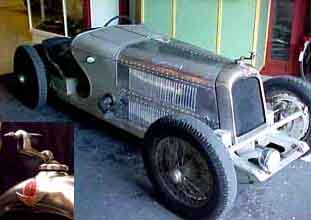
(Photo from Automuseum Deventer, NL)
The circuit
The 13.407km track, like many tracks of this era, is roughly triangular in shape: three main axes are linked by three bends. The first bend is the Yffiniac bend. Then, exactly 3.070 metres further on, comes the Croix-Gibat bend after which the drivers come into town through a 4,532-metres long road. There, in Saint-Brieuc, they take the Gouëdic bend to return to the grandstands and reach the Yffiniac bend, which is 5.805km away from Saint-Brieuc.
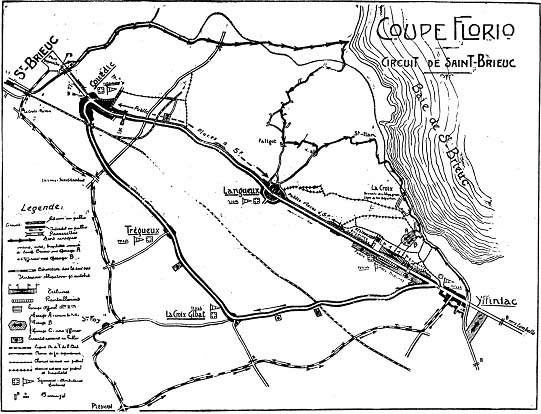
Journalists from 1927 considered the three bends the main difficulties of Saint-Brieuc track. This is why there an ambulance is situated at each bend. I would add a fourth difficulty, or to put it better, a part of the circuit which is slightly impressive: the descent just before Yffiniac bend. The view is superb but drivers had to concentrate to take the bend. I guess they were very fast through there, no just because of the speed of their cars but also because of the descent. They surely had to brake hard. Specialists regarded De Brémont as the fastest driver through this bend.
This is the Saint-Brieuc circuit as it is today:
Yffiniac bend:
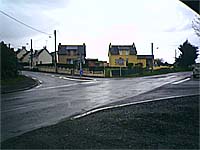
From Yffiniac bend to Mitan Bridge:
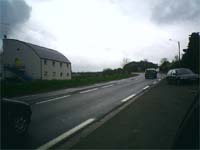 |
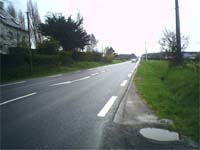 |
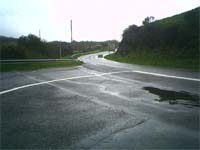 |
The Mitan Bridge:
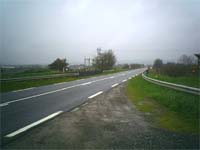
Coming to Croix-Gibat and the bend:
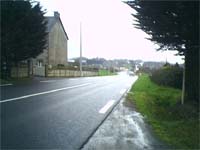 |
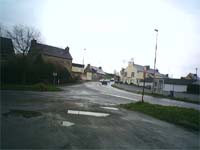 |
From Croix-Gibat to Saint-Brieuc, through Trégueux:
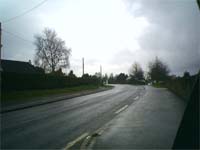 |
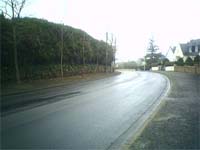 |
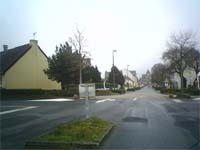 |
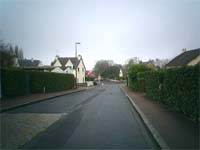 |
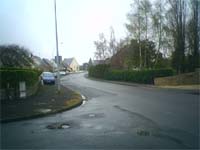 |
Coming to Saint-Brieuc:
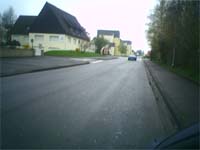 |
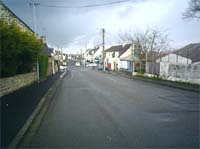 |
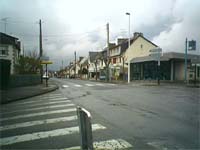 |
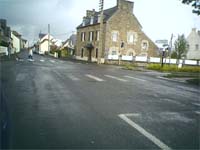 |
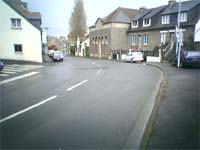 |
Just before Gouëdic bend #1: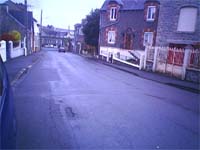 |
Gouëdic bend #1: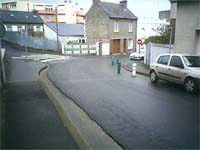 |
Between Gouëdic #1 and #2: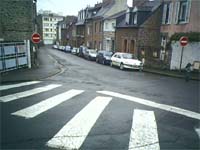 |
Gouedic #2:
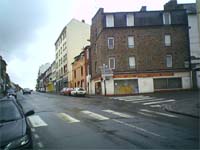
From Gouëdic bend to Langueux:
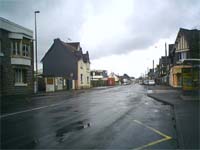 |
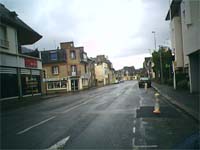 |
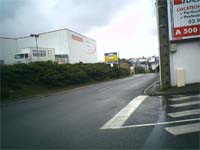 |
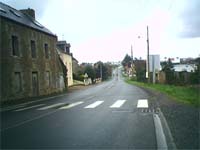 |
In Langueux:
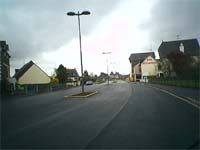 |
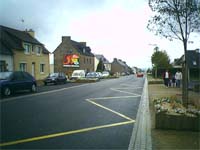 |
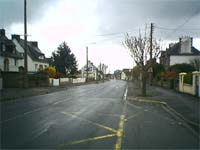 |
From Langueux to Yffiniac:
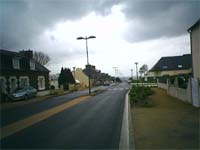 |
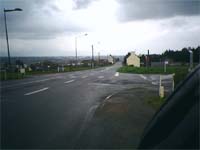 |
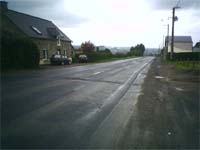 |
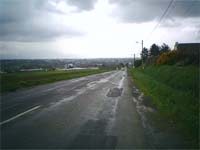 |
I did my best to translate an extract of the article written by Jehan Tholomé, a Ouest-Éclair journalist. This man had the chance to be a passenger in the 26-year-old Imbert’s Bugatti. Thus he replaced Bailly, Imbert’s mechanic, during a few laps on Saturday, 24 hours before the race. He wrote the following text about this very emotional experience:
"Everything is ready; the engine roars… Imbert is holding the steering wheel and accelerates and, already in action, 'our' Bugatti is going very fast towards Yffiniac, at 80kph. Bareheaded, my body is cramped in the seat, my eyes are protected by goggles, I have the impression to slip on the road. The fresh morning air is hitting my face and wakes me up.
Robust on its wheels, sweet in the hands of its driver, our Bugatti is going down Yffiniac road very fast. But the bend is near… Keeping cool, even smiling, Imbert stops accelerating, brakes, goes to the left before turning calmly to the right… We have passed the bend, and now we are quickly climbing the sinuous road to the railway bridge and beyond it to go down Croix-Gibat.
Bends are numerous and difficult but Imbert is taking them on the inside, without slowing down. We are on the railway bridge – Mitan bridge – and I am very impressed. The bridge, with kerbs on each side, is just after a 90° bend and there is room for one car only. Instinctively I'm closing my eyes when Imbert, who has only just started to slow down a bit, drives between the two granite kerbs. For seconds after that, I do not dare open my eyes. But Imbert is shouting at me to pump oil. So I do that while I dare to watch the road…
We are going to Saint-Brieuc now; I have not realized that we have passed the Croix-Gibat bend. I'm obeying the orders of my driver and I promise to myself to be more courageous. And here comes an occasion to prove my courage: our car goes down Gouëdic descent at 90kph. There is a difficult bend at its extremity. I'm holding on. Imbert is braking, brake blocks are squeeling… In front of us there is the wall of a house. Well, yes, once again, I admit it, I am scared.
Imbert is turning the steering wheel to the right. The bend is passed… My driver accelerates. It is over. I have overcome this experience and now I am going to stay in this car, fearless.
We are going up the Beaufeuillage climb; we have gone past the level crossing easily… We are steering towards Langueux, on the side of the road there are trees, fences, houses and spectators which seem to speed along in a furious dance. I'm looking at the speedometer; we are driving at more than 100kph… When, after Langueux, we are taking the straight line alongside the grandstands, Imbert goes on accelerating… My eyes are seeing the speedometer’s needle and I'm reading 103… 105… 110… 120… 140… 160.
195kph!!!(I am pale) It is our maximum speed. We are at this speed when going past the grandstands. Less than 800m after there is Yffiniac bend. Now I'm feeling alright. I'm relying on my driver and I am in no doubts about the stability of our car. And, as I just had to make one lap only, I'm asking Imbert to go on.
Imbert is smiling… and he makes the sign to pump in order to send oil into the engine. I do it immediately and look attentively at the Mitan bridge which frightened me so during the first lap.
This time we pass it without any problem… and go down Croix-Gibat bend. Many spectators are downhill… they are waiting for our car. We pass the bend…
There is a cloud of dust just after the bend… A car is in front of us. 'We are going to overtake it', shouts Imbert while he is accelerating.
And suddenly, the fight begins… The driver ahead of us has heard our car and does not want to be overtaken. At high speed – we are travelling at 85kph on this very difficult part of the circuit – we are in the Gouëdic descent… the other car is 50 meters in front of us; before we reach the bend we are on his tail; he is turning just before we do and the fight goes on… The dust is hurting my eyes because, as a rookie, I did not attach my goggles very well. My eyes are burnt by the wind. The wheels of the car before us is spitting little rocks which hurt my face. They are like hundreds of bees that are attacking me… We are just behind our competitor who tries to resist our attack… but, thanks to a last effort, our Bugatti jumps it… I'm looking at the other car and see Laly's Ariès, which does not insist.
And one more time this is the descent to the grandstand and Yffiniac… 150… 160… 180… 196 kph. I am not scared anymore and, with no more fear, I'm going on."
The rules or how to win the Coppa Florio
The entrants are divided into 5 categories:
| 1st class: | engine capacity: <1100cc |
| minimum weight: 350kg | |
| 2nd class: | engine capacity: 1101-1500cc |
| minimum weight: 550kg | |
| 3rd class: | engine capacity: 1501 to 2000cc |
| minimum weight: 650kg | |
| 4th class: | engine capacity: 2001-3000cc |
| minimum weight: 800kg | |
| 5th class: | engine capacity: >3000cc |
| minimum weight: 1000kg for 3000-5000cc, 1400kg for 5001-8000cc, 1500kg for >8000cc |
There is no engine capacity restriction but superchargers are forbidden.
Drivers can drive alone or, if they wish to, have a mechanic as a passenger (whose role is mainly to pump oil in the bends).
There is no constraint upon bodywork design.
The bonnet must be fastened by means of a solid belt.
The drivers who arrives first is the winner of his class (simple, isn’t it?). The most consistent among the five class winners will win the Coppa Florio. To determine the most consistent driver, the officials will calculate the average lap time of each class winner. Then they will calculate the total of the gaps between this average lap time and the time of each lap. The driver with the smallest gaps will win the Coppa Florio (not so simple, isn’t it?).
As you can see, it will take a very long time for officials to find out the name of the winner. They will have to compute all the data before Lucien Rosengart will be able to give a bunch of flowers to the driver. However, as we will see, some teams will have a clear strategy to win the Coppa Florio. They will calculate the ideal average speed all along the race and give the driver the information so that he adapts his speed.
I haven’t found the point calculation system used by the officials to calculate the gaps. Nevertheless I have determined the evolution of the average speed. It is providing us with interesting information about the consistency of each driver and is giving an illustration of the strategy (or non-strategy) of some teams.
So, let's talk about money
Of course, the drivers will be awarded prize money, following the results of the race. These are explained as follows in Ouest-Éclair:
| Winner of the Coppa Florio: | FF50,000 (€26,000) from the Conseil Général des Côtes-du-Nord |
| 2nd in the Coppa Florio: | FF20,000 (€10,400) from Vincenzo Florio |
| 3rd in the Coppa Florio: | FF10,000 (€5,200) from the City of Saint-Brieuc |
| 4th in the Coppa Florio: | FF10,000 (€5,200) from the Sables-d’Or-Les-Pins company |
| 5th in the Coppa Florio: | FF10,000 (€5,200) from the Ruhl company, based in Dinard |
The second of each class will win FF3,000 (€1,600) whereas the third will receive FF2,000 (€1,000). Prize money is financed by various towns around Saint-Brieuc, various companies and even Lucien Rosengart himself who is offering FF5,000 (€2,600).
The driver who will reach the fastest average speed will receive a statue, sculpted by Louis Nicot, a Breton artist, offered by Mr Donnay, an administrator of Chenard & Walcker.
It is important to keep in mind that only the winner of the Coppa Florio is awarded. It is not the case of the winner of the race itself, whose only gift will be Nicot’s statue. It means that even if a driver arrives first, ahead of the remaining entrants, even if he is the fastest, his result is not taken into account: he just has to win in his class and to be as consistent as possible during the race. This rule is not quite appreciated by some drivers, as we will see…
July 17, 1927: ladies and gentlemen, start your engines!
Practice begins on July 12th between 4:00am and 7:00am and will take place each morning before the race. The first drivers, like Grégoire, are in Saint-Brieuc from July 10th. Some, like "Sabipa", have tested at the track before, at the request of the organizers who needed the opinion of a professional driver about the circuit. According to observers, De Brémond (GM) seems to be the fastest driver in the bends…
During the trials it seems that the fastest driver was Etancelin (118kph), compared to Wagner (106kph) and Imbert (105kph). However, the starting grid order does not depend on the times during the trials, only on the different categories.
On Sunday, from 200,000 to 300,000 spectators are coming from all over France and also from Italy, Switzerland, Belgium, Spain and Great-Britain to attend the race under a sunny sky. One prestigious spectator is none other than His Excellency Count Manzoni, the Italian ambassador who has accepted the invitation of the organizers. There are no Germans present as there is a date clash with the German GP on the Nürburgring circuit: Otto Merz and his Mercedes-Benz are going to win this one.
To avoid any incident, 300 policemen are helped by 400 soldiers. 400 marshalls are present all around the circuit to make sure that the safety conditions of the race will be respected.
It is 10:00am when the track is closed by Lucien Rosengart and Mr Bokanowski, the French Minister of Trade, while at the wheel of a Peugeot 18HP. Now, no one except the organizers will be able to drive on the circuit. Two and a half hours later, cars are placed on the grid. The bigger engines are in the front, the smaller ones at the back. It is 1:15pm. Charles Faroux, the Clerk of the Course, is giving the start. All the cars of a same category are starting together. Each category is starting every minute. They have to follow a pace-car over 400 metres before this will go to the side of the road to let the racing cars begin the competition. The bigger engines are the first to start, and the smaller ones the last. So, at 1:19pm all the entrants are gone for a 30-lap race, that is to say 402km.
Wagner is the first leader ahead of Rigal. Lehoux is the fastest on the track as he makes the first lap in 7’53’’. The second lap is made in 7’40’’. The race is not so easy for the others: Pousse (BNC) has to stop at the Mitan bridge to change spark plugs whereas Doré (BNC) has an accident in the Monte-à-Regret ("climb with regret") hill. Fortunately, it is not serious and he returns to the track.
On the 5th lap, made in 7’30’’, Lehoux takes the lead 1’29’’ ahead of Sabipa (Bugatti). Wagner (Peugeot) is at 2’17’’ and is followed by Rigal (Peugeot) 5’’ behind. Laval (Salmson) is 3’08’’ from Lehoux and Laly (Ariès) at 3’35’’.
Between the 10th and the 15th lap, Laval is trying to overtake Imbert (Bugatti) in front of the grandstands when, finally, the driver goes slightly to the left of the road, then turns the wheel too violently to the right. He hits the pits, loses control of his Salmson and hits a post, Laval being ejected from the car. Marshalls are taking to hospital, where he has to spend one night, but fortunately he is alright.
On lap 15, after nearly two hours, the gaps are huge. Lehoux is still the leader, 6’37’’ ahead of Sabipa, 9’13’’ of Wagner, 9’43’’ of Rigal, 13’30’’ of Laly and 15’37’’ of Massé. Each of these drivers, except Rigal, is leading his category. It is a pity for Rigal because he seems to be the most consistent in terms of velocity. It may prove that the strategy of Peugeot is not too efficient. So, at this moment, the leader of the Coppa Florio is… Ariès (Laly) ahead of Peugeot (Wagner), Bugatti (Sabipa) and Salmson (Massé).
Five laps later, the classification remains the same for the race itself. Whereas, for the Coppa, some things have changed: Laly (Ariès) is still the most consistent. But it seems that 2nd is now Massé (Salmson) ahead of Sabipa (Bugatti), Wagner (Peugeot) and Lehoux (Bugatti).
Unfortunately Massé has an accident at the Croix-Gibat bend and goes off. Doré is back in the race but he knows his dreams to win the Cup are over…
While the race goes on, the official speaker is using his microphone to talk to some beautiful ladies. Maybe he is trying to seduce them (I am sure he does: we are in France, aren’t we?) but it may also prove that the race is a bit boring, as the spectators cannot know the official classification of the Coppa Florio while the race is still going. So, in this case there is nothing much to do but watch the cars pass by … and talk to the ladies.
On lap 25, after three hours, Lehoux is still leading with the average speed of 108kph, 7’28’’ ahead of Sabipa (101kph) who is followed by Wagner (at 4’45’’), Rigal (4’47’’, who has reduced the gap with his team mate), Laly (at 7’13’’), Imbert (Bugatti, at 12’29’’), Eyston (Bugatti, at 12’34’’) and the poor Massé (at 12’38’’). It seems that Laly and his Ariès are still the leaders of the Cup but they are now followed by Wagner, Sabipa, Lehoux and Massé. It is obvious that Lehoux is only interested by winning the speed race whereas it is important for Ariès to win the Cup: it seems that Charles Petiet, Ariès founder and managing director, is in the pits to help his team calculate the average speed in order to give some instructions to Laly to win the cup. It seems that Rigal, who races in the same category as Wagner, is still more consistent that the latter. Thus if Rigal would be leading the 3-litre category, he could help Peugeot win the Cup as it seems that he is nearly as consistent as Laly.
Lehoux has been leader from lap 5 and he is dominating the race. When he starts his very last lap it is evident that he is deserving this victory, even if it is not official: the goal of this race is to win the Coppa Florio, which he cannot take because of his lack of regularity. Then, about ten metres ahead of the finish line, the French driver from Algeria stops his Bugatti, gets out of his car and walks towards the pits to sit down at the side of the road.
It seems that he is not the only driver with such an attitude: the 1927 newspapers say that four other Bugatti drivers did the same. Nevertheless, if we analyze the evolution of the average speed from the 25th to the 30th lap compared with the average speed all along the race, it seems that there is only one driver who stopped and waited: Marcel Lehoux.
Why did he do that? As the result of the speed race was unofficial, it was surely a way to prove his only interest in speed instead of regularity. Was there a specific rule which could let him hope to win the Coppa by acting like this?
The contemporary newspapers seem to think that Lehoux did it to show he was only interested in overall victory. Whatever the reasons, it seems that the spectators did not understand the reaction of the driver. Most people thought that motorsport was such a difficult sport to understand!
That is why Sabipa is now the first to cross the line, some six minutes ahead of Wagner and Rigal who are crossing the line together… Laly is fourth ahead of Etancelin and Eyston who are also crossing the line together, 4’’ ahead of Imbert and 20’’ ahead of Lehoux who, after some thirty minutes after his surprising stop, decides it is now time to finish the race…
Now, the officials are having to compute the speed of the winners of each class at each lap… in order to name the official victor of the Coppa. It is taking a lot of time… and finally, the winner of the day is Laly at the wheel of his Ariès, just a few points ahead of Wagner, who is followed by Etancelin, Sabipa and Massé, who is down in the final classification because of his accident.
In the evening, the drivers and officials are coming down to the Rosaria, Rosengart’s house, for a ceremony. The winners are receiving their prizes. Mr Bokanowski, the Minister of Trade, is saying a few words about the unfortunate Laval who is still in hospital: "Tomorrow, as he will wake up, his nurse will have to tell him that tonight we all wished him a quick recovery and we asked him to remember one only thing of this race: the happy welcome he received from Saint-Brieuc inhabitants."
The Rosaria Hotel:
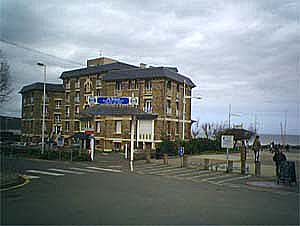
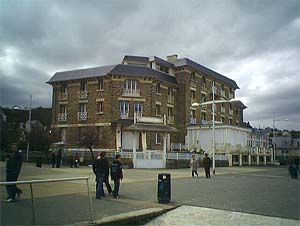
The race is now over. There will be two other Coppa Florio races, in 1928 and 1929. But, this time, they will take place in Italy. The winner of both races will be Albert Divo and his Bugatti. This is how the French constructor from Molsheim will be the final winner of the Coppa Florio.
A tribute to Ariès…
Baron Charles Petiet, despite having an engineering degree, decides to begin his career as a worker in the Panhard manufacture in Paris in order to learn the maximum of things needed to reach his goal: creating his own car manufacture. Then, in 1903, he creates the Ariès car company in Villeneuve-la-Garenne, near Paris.
As many other car constructors, Charles Petiet believes that racing is the best way to promote the quality of his cars. This is why, as soon as 1907, the first Ariès racing car is built. The car takes part in the Circuit des Ardennes, the Coupe de la Presse and even in the Coppa Florio but it is an also-ran. A brand new racing cycle-car is built and it wins some races in 1908. Unfortunately, Charles Petiet decides to quit racing at the end of the season because of financial difficulties.
In 1913, three Ariès are among the participants of the Tour de France. It is a success as an Ariès wins the race. Unfortunately this comeback is temporary: about one year later the first world war begins.
As soon as war is over the Ariès company moves to Courbevoie. Step by step some Ariès take part in races but these cars are not really made for racing. This is why in 1925 the Ariès "Grand Sport" is created to take part in various competitions. It is a success, mainly thanks to driver Robert Laly.
But these successes are not really going to help Ariès which is a small car manufacturer, with only 20,000 cars built in 35 years. Thus from 1923 onwards, Charles Petiet is struggling to keep his company alive. He even tries to merge with other small French car constructors but can’t find an agreement and decides to close the company in 1938.
…and Laly
Despite some journalists calling him André that is mistaken, as his true Christian name is Robert. He begins his career as a mechanic. This is how he gets to take part in the 1914 Indy 500 alongside René Thomas, who wins the American race at the wheel of a Delage. Laly even works a miracle: about 60 laps before the end of the race he sees that the exhaust pipe is broken. He decides to take his own trouser belt to try to repair it. However, it does not work, so with his own hands (!) he holds the burning pipe in order to avoid the Delage giving up!
It seems that after the war he meets Jean Chassagne to become his mechanic. The pair is 2nd in the 1921 Italian GP, driving a Ballot, and wins the 1922 Tourist Trophy with a Sunbeam. The two become close friends: all along his career as a driver Laly is often acting as Chassagne’s co-driver. So the latter may have helped him to become a racing driver? Robert Laly really begins racing as a driver in 1924 and it seems that he is not going to drive anything but an Ariès.
In 1924 he takes part at Le Mans but has to retire. In 1925 he is 2nd in the George Boillot Cup in Boulogne. In 1926 he is back at Le Mans but once again he has to retire. His performance in the Spa 24 hours is better, ranking 4th. He is also 2nd in a minor race near Lille, the Circuit des Routes Pavées.
1927 is surely his best season. First he is about to win Le Mans with Chassagne but they retire two hours before the end of the race while leading in the Ariès, three laps ahead of Davis and Benjafield’s Bentley, which will go on to win the French race. Then, he ranks 3rd – still with Chassagne – in the Spa 24 Hours and, as we saw it in this article, he also wins the Coppa Florio. He then goes on to win the George Boillot Cup and performs well in the 6 hours of Dijon (2nd) and the Circuit des Routes Pavées (3rd).
It seems that he goes on racing until 1930 but, despite a 5th place in Spain in 1928, his results are not very good. One of the reasons is surely the decline of Ariès.
Results of the 1927 Coppa Florio
| 1° ARIES (driver: Laly) | 55 points |
| 2° PEUGEOT (driver: Wagner) | 63 points |
| 3° BUGATTI (driver: Etancelin) | 98 points |
| 4° BUGATTI (driver : Sabipa) | 124 points |
| 5° SALMSON (driver : Massé) | 614 points |
Results of the race
| 1° Sabipa | Bugatti | 3h56’51’’ (101,888 kph) | 1st in 1101-1500cc |
| 2° Wagner | Peugeot | 4h02’59’’ (99,316 kph) | 1st in >3001cc |
| 3° Rigal | Peugeot | 4h02’59’’ (99,316 kph) | 2nd in >3001cc |
| 4° Laly | Ariès | 4h11’29’’ (95,960 kph) | 1st in 2001-3000cc |
| 5° Etancelin | Bugatti | 4h18’28’’ (93,367 kph) | 1st in 1501-2000cc |
| 6° Eyston | Bugatti | 4h18’28’’ (93,367 kph) | 2nd in 1501-2000cc |
| 7° Imbert | Bugatti | 4h18’32’’ (93,343 kph) | 2nd in 1101-1500cc |
| 8° Lehoux | Bugatti | 4h18’48’’ (93,247 kph) | 3rd in 1501-2000cc |
| 9° Massé | Salmson | 4h21’05’’ (92,241 kph) | 1st in <1101cc |
| 10° Brunet | Talbot | 4h27’31’’ (90,208 kph) | 2nd in 2001-3000cc |
| 11° Grégoire | Tracta | 4h29’47’’ (89,450 kph) | 2nd in <1101cc |
| 12° Bloch | Lorraine-Dietrich | 4h37’46’’ (86,880 kph) | 3rd in >3001cc |
| 13° Viollet-Morris | BNC | 4h39’05’’ (86,470 kph) | 3rd in <1101cc |
| 14° De Brémond | GM | 4h40’07’’ (86,151 kph) | 4th in <1101cc |
| 15° Pousse | BNC | 4h48’13’’ (83,730 kph) | 5th in <1101cc |
| 16° Mottet | D’Yrsan | 29 laps | 6th in <1101cc |
| 17° Andrieux | Christiane 8 | 29 laps | 4th in 1501-2000cc |
| 18° Maillet | Tracta | 29 laps | 7th in <1101cc |
| 19° Valette | Salmson | 29 laps | 8th in <1101cc |
| Doré | BNC | result unknown | |
| Lepicard | Donnet | result unknown | |
| Laval | Salmson | retired |
The Coppa Florio records
| 1905 | Brescia | Carlo Raggio | ITALA |
| 1907 | Brescia | Ferdinando Minoia | ISOTTA-FRASCHINI |
| 1908 | Bologna | Felice Nazzaro | FIAT |
| 1914 | Madonie | Felice Nazzaro | NAZZARO |
| 1921 | Brescia | Jules Goux | BALLOT |
| 1922 | Madonie | André Boillot | PEUGEOT |
| 1924 | Madonie | Christian Werner | MERCEDES |
| 1925 | Madonie | André Boillot | PEUGEOT |
1st winner: PEUGEOT
| 1926 | Madonie | Meo Costantini | BUGATTI |
| 1927 | St-Brieuc | Robert Laly | ARIES |
| 1928 | Madonie | Albert Divo | BUGATTI |
| 1929 | Madonie | Albert Divo | BUGATTI |
Initially seven races were planned for the 2nd version of the Coppa Florio but only four were actually organized. Bugatti dominated the competition, except in Saint-Brieuc.
2nd winner: BUGATTI
